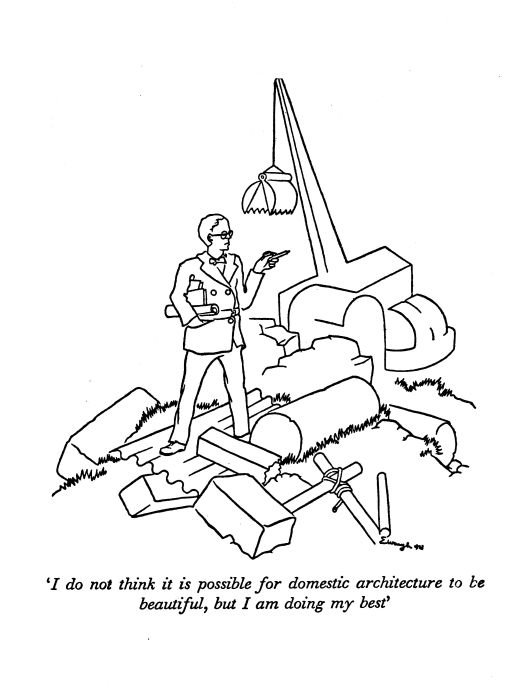


05/07/2020
Down through history, cities were usually “demographic sinks,” meaning that the population generally didn’t reproduce itself, dying off faster than it bred, requiring replacement from the healthier countryside. For example, Rome today is populated less by the descendants of the residents of Rome in 1 AD than by the descendants of country folk from adjoining rural areas.
At the moment, low density living and private vehicles seem to be healthier than high density living and mass transit.
Here’s an interesting argument from the NYT opinion page that changes in 20th Century architectural and urban planning taste were driven by the waxing and waning of fears of infection:
Will You Want to Go Straight Back Into the Crowd?
Planners once dreamed of cities with vast empty plazas and quiet streets. Post-pandemic, might they do so again?By Richard J. Williams
Richard J. Williams is a professor of contemporary visual cultures at the University of Edinburgh and the author, most recently, of “Why Cities Look the Way They Do.”May 5, 2020
… But the idea that cities ought to be crowded is really quite new [in 20th Century prestige culture]. We’ve learned to like density in the Western world of late, but in cities like New York and London, the equation of the urban crowd with urban success has fluctuated, and its recent ascent is one of many oscillations. In New York, its recent history can be traced back to Jane Jacobs’s 1962 book, “The Death and Life of Great American Cities,” which made the then-incendiary argument that cities were, in effect, their public lives: What happened on the street corner was the city, and, crudely put, the more of it the better. Ms. Jacobs was a lonely voice at the time against the postwar trends toward urban decentralization and suburbanization, and for the human life of the neighborhood and its streets.
Jacobs’ basic argument was that her neighborhood, Greenwich Village in Manhattan, with its shaded wide sidewalks for children to play on under the eye of shopkeepers who operated out of storefronts underneath medium-height apartment buildings where the kids lived, was a nice place to live. Now, of course, so many people have come to agree with her that families with kids can’t afford to live there anymore …
Things really got going, however, in the Catalan metropolis Barcelona, via politician-planner Oriol Bohigas. Between 1981 and 1987, under his guidance at the Office of Urban Projects, the city built or remade some 160 public spaces and filled them with people. Few Western urban leaders were unimpressed by the spectacle, especially when they saw its mature form at the 1992 Olympics.
Today, Barcelona is an immense tourist attraction, but when I went to Europe in 1980, I didn’t bother to go there. (Although an Australian tourist in Switzerland told me that when he was in Barcelona a few weeks before, he was wondering what that enormous racket coming from downtown was. Finally, it was over and all these pedestrians came flooding by. He asked one who told him that The Clash had just finished playing a free outdoor concert.) Barcelona 1992 was probably the most successful Olympics in terms of glamorizing the host city since Berlin 1936. The Games were no better organized than Atlanta 1996, but when your bus was an hour late, you were still killing an hour in Barcelona rather than in Atlanta.
How attractive urban crowds could be! And how much money could be made when you gave them the space in which to eat and drink!
Donald Trump was one of the early investors in the restoration of Times Square from Taxi Driver wasteland to tourist capital of the world.
… Following the Barcelona example, public space became a defining part of the global city and urban crowds filling public spaces began to seem like both an economic and a moral good. “The Great Inversion,” the journalist Alan Ehrenhalt called it in 2013, a process whose architectural emblems were the spaces wherever a crowd might gather: the street corner, the public square, the park. What Mr. Ehrenhalt and others described was partly demographic, partly symbolic: People really were coming back to live in cities, but they also wanted to see and be seen in them.
But however much that process looks like common sense now, it was itself a reaction to the midcentury urban decline in the West. That process wasn’t all to do with Detroit-style industrial decay; it had just as much to do with a planned dispersal that was ultimately about the fear of urban disease in the 19th-century city. To understand that fear, there’s no better source than Friedrich Engels’s “The Condition of the Working Class in England,” published in German in 1845 and of extraordinary and durable influence worldwide. Its account of industrial Manchester was also an account of its sickness and, by proxy, its density. The city’s lightless, airless streets teeming with the poor became a figure of long-lasting architectural horror; so much of modernist planning was a reaction to places like it.
If density was disease for modernists, it followed that their cities were about keeping people apart. Look back at the utopian schemes for cities of the first half of the 20th century, and the same hygienic preoccupations come up again and again: There must be light and space and fresh air. The Swiss-French architect Le Corbusier wrote about these things in his book “Vers Une Architecture” (translated as “Towards a New Architecture”).
Here’s St. Louis’s Pruitt-Igoe housing complex, designed by Corbusier fan Minoru Yamasaki in the 1950s and blown up in the 1970s:
Parts of the book read like comedy now — the author’s attempt to turn his own obsession with hygiene into an avant-garde manifesto. But it was serious when it was published in 1923, the Spanish flu pandemic having just run its course.
As I’ve mentioned before, when I moved to Santa Monica in 1981, my parents were very concerned about Santa Monica’s notorious foggy dampness. My parents had both moved to Southern California before penicillin arrived in 1945, so fear of tuberculosis was a huge factor in driving migration of well-to-do people, like my paternal grandfather, from the Midwest. The cool coastline was largely shunned in favor of the drier inland areas like Pasadena, which attracted the health conscious from the 1880s to the 1940s.
 Then about 1943, smog became a problem, which blew inland on the ocean breezes, so Pasadena began to fall out of favor relative to the coast.
Then about 1943, smog became a problem, which blew inland on the ocean breezes, so Pasadena began to fall out of favor relative to the coast.
Now the smog is gone, so both Santa Monica and Pasadena are expensive.
In his first venture into town planning, Le Corbusier designed the imaginary Ville Contemporaine, a city of vast empty spaces. My copy of his book “The City of Tomorrow and Its Planning,” published in 1929, has a perspective drawing of the Ville Contemporaine on the cover, showing in the foreground a sunlit cafe terrace looking out toward vast cruciform towers in parkland; it is all light and space and greenery, and apart from some tiny specks in the far background, entirely free of human beings.
Its emptiness has been the source of endless critique; it has been cited as evidence of modernism’s moral bankruptcy in general, and Le Corbusier’s inhumanity in particular. But place it in its post-pandemic context, and it begins to look different.
 I notice now that this cover illustration of Corbusier’s book is in the same style as the cartoons that Evelyn Waugh drew to illustrate his 1928 first novel Decline and Fall, which features a modernist architect modeled on Corbusier.
I notice now that this cover illustration of Corbusier’s book is in the same style as the cartoons that Evelyn Waugh drew to illustrate his 1928 first novel Decline and Fall, which features a modernist architect modeled on Corbusier.
The Ville Contemporaine inspired plenty of real-life experiments, and perhaps the most closely related is Brasília, the modernist capital of Brazil, which turned 60 in April.
Much of 20th Century thought is related to actual leaps forward in scientific understanding in 19th and early 20th Century thought, such as Pasteur and Koch coming to understand the germ theory of disease and the beginnings of evolutionary theory and genetics, and scaring the hell out of people.
For example, Hitler was obsessed by fear of “race poisoning,” not wholly unlike how my Swiss German grandfather of similar vintage was obsessed with fear of food poisoning by factory-made foods. (See Upton Sinclair’s The Jungle for why his crackpot worries weren’t all that crackpot.)
So he moved to Pasadena, with its year-round growing season, to be able to grow much of his own food in his own yard. (Which was a much better idea than what Hitler came up with.)